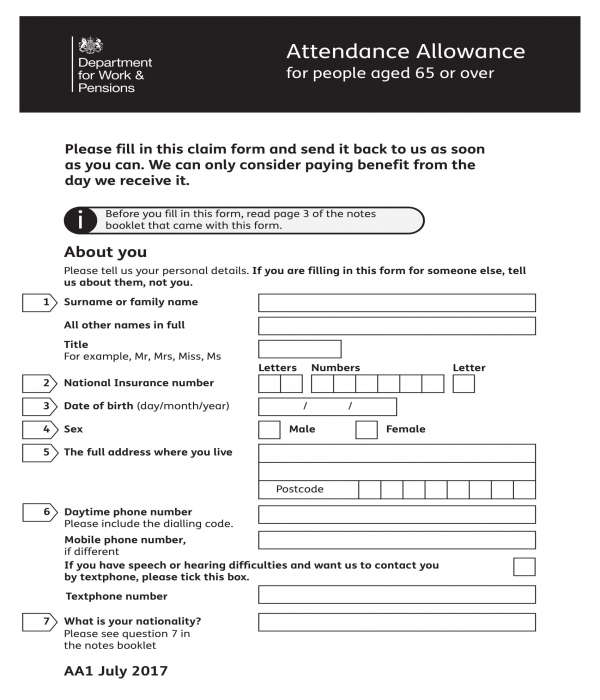Having a disability and growing to an older age should not be a hindrance for an individual to fulfill the goals left for him to achieve in his life. This is the reason government agencies and even private organizations offer a hand to those who are eligible for their benefits program, specifically an attendance allowance program. The main objective of an attendance allowance program is to help those who are in need and have met the requirements set out by the founding organization in relation to the medical and financial needs of the beneficiary.
What Is an Attendance Allowance Form?
An attendance allowance form is a document which is provided to those who are eligible individuals aged sixty-five years and above as well as those who are disabled or have illnesses needing supervision and care from a care provider. The purpose of an attendance allowance form is to obtain the particulars of the claimant or the applicant in order to have a record in the database of the agency supplying the allowance benefits.
Attendance Allowance Form Sample
Who Can Use the Attendance Allowance Form?
Attendance allowance forms are not only to be used by those who are beyond the ages of sixty-five years and above but also those individuals who are representing or an authorized representative of an eligible applicant. Yet, in order for the representative to be acknowledged and be able to file a claim to the organization, he should be able to supply ample details about the applicant or the person that he is representing along with his own personal information.
How to Fill Up an Attendance Allowance Form
Regardless of the organization who is offering and organizing an attendance allowance program, there is only one general attendance allowance form which is created and used by applicants and claimants. To fill out this general form, the steps below must be followed:
Step 1: Determine which sections are intended to be completed. There are two separate sections in an attendance allowance form; one for the applicant himself and the other for his authorized representative. By reading through the form along with the form’s instructions, the user of the form will be able to have an assurance that he is filling out the right areas and portions for the application and claim.
Step 2: Disclose personal particulars. Regardless of the type of user, whether the applicant or a mere representative, he will be required to disclose his general information on the form. The entries will include the name of the user, national insurance number, date of birth, gender, full address, and contact information. The nationality of the user with the list of countries or States where he recently went for either a vacation or other purposes is also to be included in the form as well as the other benefits or programs that he is currently enrolled or registered in. Moreover, if the user of the form is an authorized representative, he must clearly indicate his relationship with the applicant as to whether he is an appointee, a holder of a power of attorney, a deputy, a tutor, or a curator. This allows the organization in determining the level of authorization that the user is permitted and limited with regards to the allowance application and in claiming the applicant’s allowance benefits.
Step 3: Enlist health and medical details. This is the section where the user will be presented with a table consisting of four columns and a number of rows to collect the names of the illnesses or the diseases that the applicant have acquired with the number of years the diseases prevailed, the medicines taken by the applicant, and the number of dosage for each medicine. In addition to the medication and illness information, the user will also have to state the individuals who are not the general physician or practitioners who prescribed the medications and helped the applicant during the period of the illness. Along with this, the details of other people who aided the applicant including his care provider or caretaker are also recommended to be disclosed in the form. All of this information such as the number of heads that helped the applicant and is currently helping the applicant will allow the organization in determining how much will the applicant’s allowance amount will be.
Step 4: Sign the consent statement. A medical consent and an information verification consent are the common types of consent statements which can be incorporated in the form to be signed by the user. The consent is intended for informing the applicant or the user about the need of the organization in gathering his details to conduct or execute a verification and validation procedure. The organization will also include a shortened statement indicating the agreement of the applicant or the user of the form to contact or reach out the people enlisted in the document such as the applicant’s physician, caretakers, and other involved parties.
Step 5: Include details about services needed and accommodation information. The objective of an attendance allowance program is to help an individual in having a better life regardless of the factors which can hinder him from achieving his goals and continue living. This is why it is significant for the user of the form to indicate details about the services that he will be needing and those that he recently took such as the specific medical examinations or tests that he was required to undergo as well as the aids that he needs including elevator lifts, eyeglasses, and wheelchairs. The amount and type of care that the applicant needs throughout the day should also be stated in the form ranging from his need for another person to help him sit on a chair and feed him during mealtime up to guiding him to sleep through the night.
Step 6: Choose the method of payment. It is essential that an applicant is a bank account holder to allow the organization in sending the allowance payments directly to the applicant’s account during payment periods. In this section, the applicant’s code and account number will be disclosed along with the bank’s reference number.
Step 7: Allow a witness to fill in the witness statement portion of the form. A witness is an individual who knew the applicant before and during the period when he acquired the illness or the disease. The witness statement section will gather the name of the witness, the frequency of him meeting the applicant, the disabilities and illnesses that the witness saw the applicant has, as well as the job, address, and phone number of the witness.
Step 8: Include extra information. The form contains an area where the user can disclose other details which were not collected from the other sections and fields of the form. This should be filled in with the details which are necessary to be known by the organization providing the allowance benefits to the applicant.
Step 9: Read and sign the declaration. A declaration statement is for indicating that the applicant or the user is aware of the various details and information he disclosed in the form and that each data entry were facts and accurate to his knowledge. An understanding about the rules and regulations to be mandated and observed by the applicant is also incorporated in the declaration. To complete this section of the form, the user must affix his signature along with the date of when the form was fulfilled and submitted to the organization.
Step 10: Mark the checklist and enlist the documents to be enclosed with the allowance form. This is the last step in completing an attendance allowance form wherein the user will have to determine what should be his next move for claiming the allowance such as reviewing his entries in the form and ensuring that the details are exact. The types of legal forms, as well as medical forms which will be enclosed with the attendance allowance form, must also be indicated to allow the organization in knowing what documents will be used for verifying the claims and proving the disability and eligibility of the applicant for the allowance program.
Some of the known documents which can be enclosed with an attendance allowance form include dental and medical reports of the applicant that indicates his current illness and disability. Another document is a disability statement or an affidavit indicating the claim of the applicant for his disability. Also, an authorization statement for the applicant’s representative to be acknowledged by the organization can be beneficial for identifying the representative and clearing out the doubts of the organization to whether or not they will accept the completed attendance allowance form filled out by the representative of the applicant or not.
However, regardless of the type of document to be enclosed, each form must be up to date and should be signed or have been reviewed by authorized professionals such as a licensed medical practitioner or medical care provider to ensure a legal and validated document to be submitted for the purpose of applying for an attendance allowance claim.

